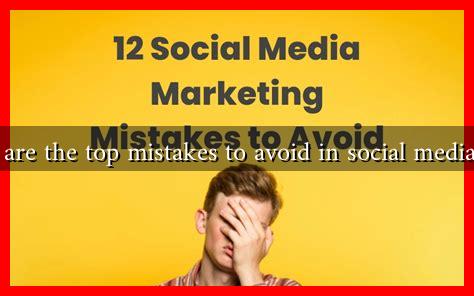-
Table of Contents
What are the Top Mistakes to Avoid in Social Media Sales
In the digital age, social media has become a powerful tool for businesses to connect with customers and drive sales. However, many companies still struggle to leverage these platforms effectively. Understanding the common pitfalls in social media sales can help businesses optimize their strategies and achieve better results. This article explores the top mistakes to avoid in social media sales, providing insights and examples to guide your approach.
1. Neglecting Audience Research
One of the most significant mistakes businesses make is failing to understand their target audience. Without proper audience research, companies risk creating content that does not resonate with potential customers.
- Ignoring Demographics: Knowing the age, gender, location, and interests of your audience is crucial. For instance, a study by Sprout Social found that 64% of consumers want brands to connect with them on social media.
- Overlooking Behavior Patterns: Understanding when your audience is most active online can help you time your posts for maximum engagement. Tools like Facebook Insights can provide valuable data on audience activity.
By investing time in audience research, businesses can tailor their messaging and improve engagement rates significantly.
2. Focusing Solely on Sales
While the ultimate goal of social media is to drive sales, focusing solely on selling can alienate your audience. Social media is about building relationships and engaging with customers.
- Hard Selling: Constantly pushing products can lead to follower fatigue. Instead, aim for a balance between promotional content and value-driven posts.
- Neglecting Engagement: Failing to respond to comments or messages can create a disconnect. Engaging with your audience fosters loyalty and trust.
For example, brands like Nike and Starbucks excel at creating engaging content that resonates with their audience, rather than just pushing products.
3. Inconsistent Branding and Messaging
Inconsistency in branding and messaging can confuse potential customers and dilute your brand identity. It’s essential to maintain a cohesive voice and visual style across all platforms.
- Visual Identity: Use consistent colors, logos, and imagery that reflect your brand. A study by Lucidpress found that consistent branding can increase revenue by up to 23%.
- Voice and Tone: Whether your brand is professional, casual, or humorous, ensure that your messaging aligns with your brand identity.
Companies like Apple and Coca-Cola are prime examples of brands that maintain a consistent image across all their social media channels.
4. Ignoring Analytics and Metrics
Many businesses overlook the importance of tracking their social media performance. Analytics provide insights into what works and what doesn’t, allowing for data-driven decisions.
- Failing to Set KPIs: Without clear Key Performance Indicators (KPIs), it’s challenging to measure success. Common KPIs include engagement rates, click-through rates, and conversion rates.
- Not Analyzing Data: Regularly reviewing analytics can help identify trends and areas for improvement. Tools like Google Analytics and Hootsuite can provide valuable insights.
For instance, a report by HubSpot revealed that companies that actively use analytics are 5 times more likely to make better decisions than those that don’t.
5. Underestimating the Power of Paid Advertising
While organic reach is essential, underestimating the power of paid advertising can limit your social media sales potential. Paid ads can significantly enhance visibility and reach.
- Targeted Advertising: Platforms like Facebook and Instagram offer advanced targeting options that allow you to reach specific demographics, interests, and behaviors.
- Retargeting Campaigns: Retargeting ads can help re-engage users who have previously interacted with your brand, increasing the likelihood of conversion.
According to a study by WordStream, businesses make an average of $2 in revenue for every $1 spent on Google Ads, highlighting the effectiveness of paid advertising.
Conclusion
Avoiding these common mistakes in social media sales can significantly enhance your business’s online presence and sales performance. By conducting thorough audience research, balancing promotional content with engagement, maintaining consistent branding, leveraging analytics, and utilizing paid advertising, businesses can create a robust social media strategy that drives results. Remember, social media is not just a sales platform; it’s a space for building relationships and fostering community. By focusing on these key areas, you can position your brand for success in the competitive landscape of social media sales.
For further reading on effective social media strategies, check out HubSpot’s Social Media Marketing Guide.


